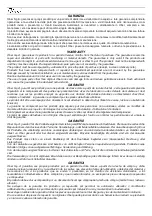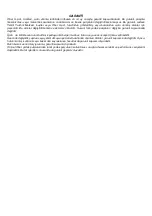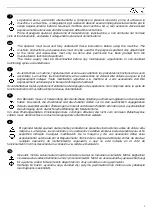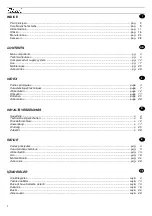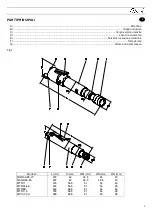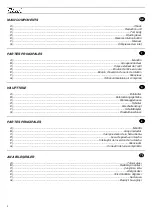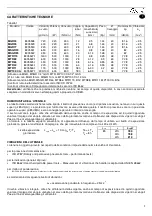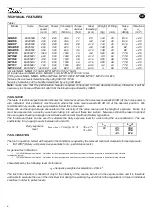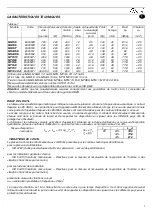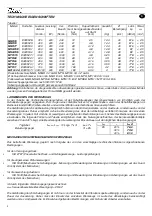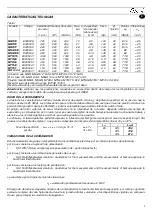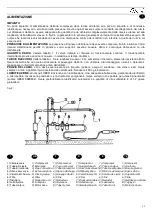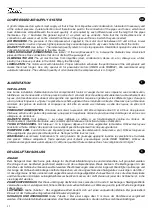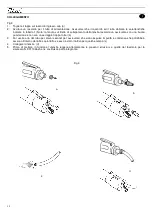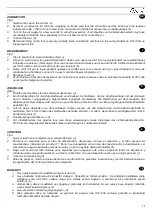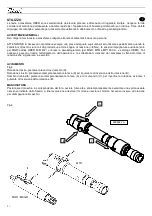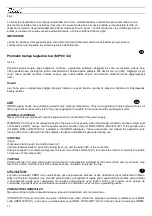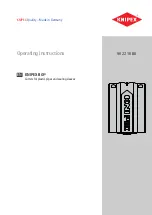
6
TECHNICAL FEATURES
GB
Table 1
Model
Code
No-load
speed
Power Consumpti
on
Torque
at 6 bar
Steel
threading
Weight
Ø fitting
Noise
Lp
Vibrations
a
h
(rpm)
(W)
(Nl/min.)
(Nm)
(mm)
(Kg)
(mm)
(dB(A))
(m/s
2
)
MGR33
8305528
720
220
430
12
2-5
1.44
40
81.6
< 2.5
MGR55
8305529
400
220
430
21
4-8
1.44
40
81.6
< 2.5
MGR77
8305530
220
220
430
28
4-12
1.44
40
81.6
< 2.5
MSGR33
8305531
650
300
600
16
3-8
1.48
40
82
< 2.5
MSGR55
8305532
350
300
600
30
4-14
1.48
40
82
< 2.5
MTR115
8305527.1
1400
500
1000
13
3-8
3.25
48
77.8
< 2.5
MTR88
8305522.1
600
500
1000
28
4-12
3.9
60
77.8
< 2.5
MTR66
8305525.1
450
500
1000
38
4-16
3.55
48
77.8
< 2.5
MTR44
8305524.1
270
500
1000
64
4-16
3.55
48
77.8
< 2.5
MTR11
8305526.1
100
500
1000
180
6-30
4.2
60
77.8
< 2.5
MP100 CA
8305537.1 300/100
600
800
180
6-30
4
58
77.8
< 2.5
Air inlet MGR, MSGR 1/4” GAS; MTR, MP100 CA 1/2" GAS
Ø inside tube min. MGR 8 mm, MSGR 10 mm, MTR, MP100 CA 13 mm
Fitting chuck MGR, MSGR, MTR44, MTR66, MTR115: B12; MTR88, MTR11, MP100 CA: B16
Noise emission levels determined by using ISO/CD 15744
Levels of vibrations at the handle determined by using ISO 8662
Note:
make sure that the performance features required correspond to those described above, otherwise it will be
necessary to choose a different model from the broad range offered by OBER.
TOOL NOISE
The table of technical specifications indicates the noise level- where the noise level exceeds 85 dB (A) the noise power is
also indicated. Ear protectors must be worn where the noise level exceeds 85 dB (A) at the operator position. We
recommend that you also wear ear protectors below this noise level.
Noise risk and hearing damage are related to the intensity of the noise source and the length of exposure. Noise risk
must be assessed on a case by case basis taking into account these two factors. Measures should be taken to protect
the user against hearing damage in accordance with current Health and Safety regulations.
The formula and table can be used to calculate the daily exposure level for a tool using the use coefficient c. The use
coefficient
c
for a tapping head is between 20 and 40%.
L
eq,d
= L
eq
+ 10 Log
10
T
e
/ T
0
TOOL VIBRATION
The tool in question, tested with regard to the conditions required by the relevant technical standards for feed pressure:
•
ISO 2787 (Rotary and percussive pneumatic tools - performance tests)
for general test indications:
•
ISO 5349 (Mechanical vibration - Guidelines for the measurements and the assessments of human exposure to hand-transmitted vibration
for weighting factors:
•
ISO 5349 (Mechanical vibration - Guidelines for the measurements and the assessments of human exposure to hand-transmitted vibration
characterised by the following level of vibrations:
a
h
= frequency-weighted acceleration <2.5m/s
2
The risk from vibrations is linked not only to the intensity of the source, but also to the exposure time and it is therefore
advisable to evaluate the use of the individual tool during the working day and stick to the regulations in force in individual
countries in order to protect users.
Te= c T
0
T
0
= 8h
L
eq
c
L
eq,
d
85
20%
30%
40%
78,0
79,8
81,0
Dally exposure
level
Содержание MGR33-55-77
Страница 4: ......


